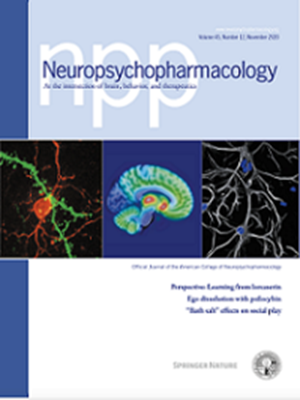A molecular mechanism mediating clozapine-enhanced sensorimotor gating
IF 6.6
1区 医学
Q1 NEUROSCIENCES
引用次数: 0
Abstract
The atypical antipsychotic clozapine targets multiple receptor systems beyond the dopaminergic pathway and influences prepulse inhibition (PPI), a critical translational measure of sensorimotor gating. Since PPI is modulated by atypical antipsychotics such as risperidone and clozapine, we hypothesized that p11—an adaptor protein associated with anxiety- and depressive-like behaviors and G-protein-coupled receptor function—might modulate these effects. In this study, we assessed the role of p11 in clozapine’s PPI-enhancing effect by testing wild-type and global p11 knockout (KO) mice in response to haloperidol, risperidone, and clozapine. We also performed structural and functional brain imaging. Contrary to our expectation that anxiety-like p11-KO mice would exhibit an augmented startle response and heightened sensitivity to clozapine, PPI tests showed that p11-KO mice were unresponsive to the PPI-enhancing effects of risperidone and clozapine. Imaging revealed distinct regional brain volume differences and reduced hippocampal connectivity in p11-KO mice, with significantly blunted clozapine-induced connectivity changes in the CA1 region. Our findings highlight a novel role for p11 in modulating clozapine’s effects on sensorimotor gating and hippocampal connectivity, offering new insight into its functional pathways.

介导氯氮平增强感觉运动门控的分子机制。
非典型抗精神病药物氯氮平靶向多巴胺能通路以外的多个受体系统,并影响脉冲前抑制(PPI),这是感觉运动门控的关键翻译测量。由于PPI是由非典型抗精神病药物如利培酮和氯氮平调节的,我们假设p11-一种与焦虑和抑郁样行为和g蛋白偶联受体功能相关的衔接蛋白-可能调节这些作用。在这项研究中,我们通过测试野生型和全局p11敲除(KO)小鼠对氟哌啶醇、利培酮和氯氮平的反应来评估p11在氯氮平的ppi增强作用中的作用。我们还进行了结构和功能脑成像。与我们的预期相反,焦虑样p11-KO小鼠会表现出增强的惊吓反应和对氯氮平的更高敏感性,PPI测试显示p11-KO小鼠对利培酮和氯氮平的PPI增强作用没有反应。成像显示p11-KO小鼠明显的区域脑容量差异和海马连通性降低,氯氮平诱导的CA1区连通性变化明显减弱。我们的研究结果强调了p11在调节氯氮平对感觉运动门控和海马连接的影响中的新作用,为其功能途径提供了新的见解。
本文章由计算机程序翻译,如有差异,请以英文原文为准。
求助全文
约1分钟内获得全文
求助全文
来源期刊

Neuropsychopharmacology
医学-精神病学
CiteScore
15.00
自引率
2.60%
发文量
240
审稿时长
2 months
期刊介绍:
Neuropsychopharmacology is a reputable international scientific journal that serves as the official publication of the American College of Neuropsychopharmacology (ACNP). The journal's primary focus is on research that enhances our knowledge of the brain and behavior, with a particular emphasis on the molecular, cellular, physiological, and psychological aspects of substances that affect the central nervous system (CNS). It also aims to identify new molecular targets for the development of future drugs.
The journal prioritizes original research reports, but it also welcomes mini-reviews and perspectives, which are often solicited by the editorial office. These types of articles provide valuable insights and syntheses of current research trends and future directions in the field of neuroscience and pharmacology.
 求助内容:
求助内容: 应助结果提醒方式:
应助结果提醒方式:


